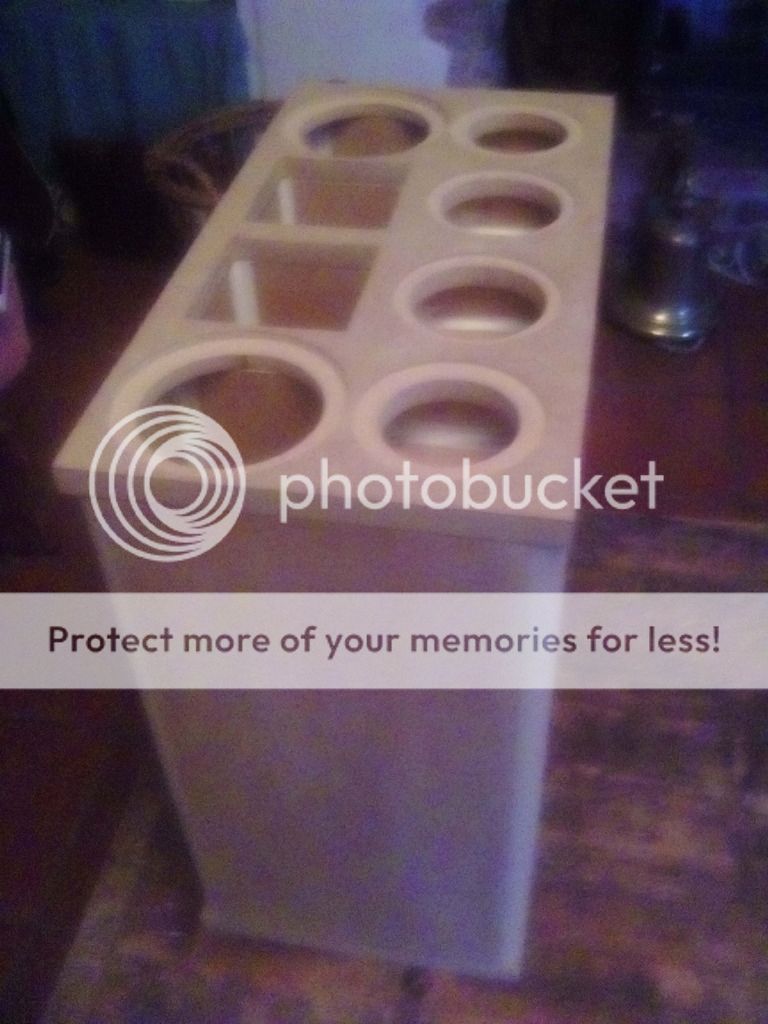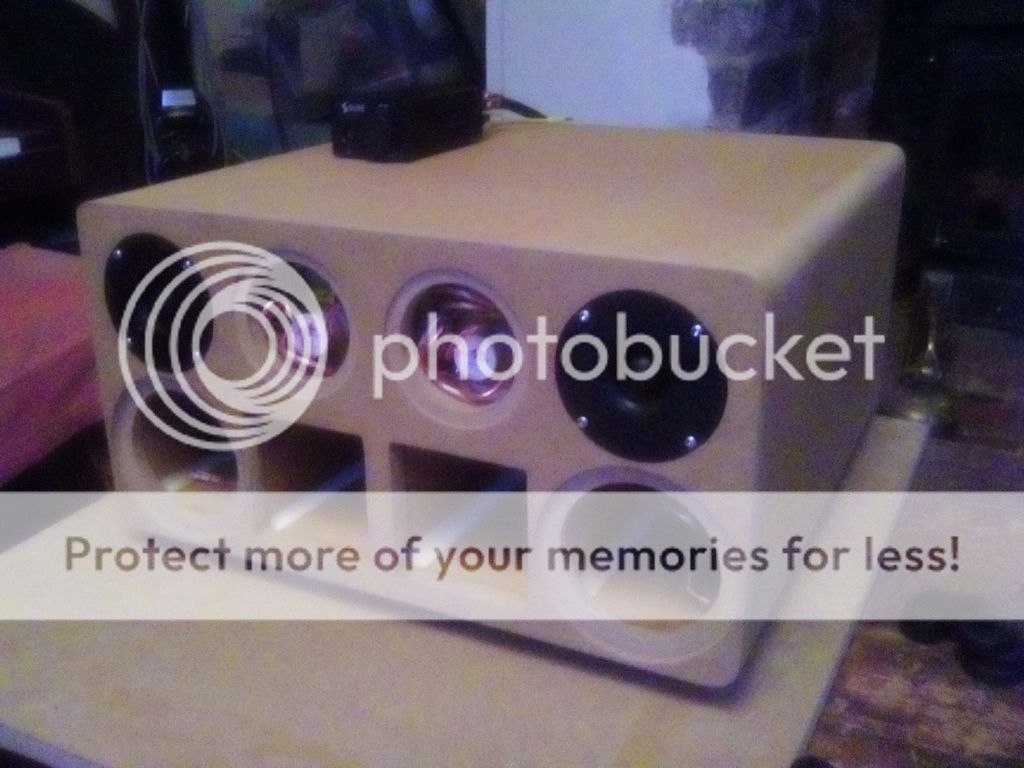Hello,
I've always liked the bose waveguide but realize it is a product based on some fundamentals that revolve around the tline design of speaker enclosure
So i set about building my own project stereo tline box.
Any comments on the choices I have made are appreciated.
So
2 scanspeak 12w/8524g00 8ohm fs 52Hz 40wrms
2 Monacor DT-99 8ohm rec x over 2500hz 40wrms
6db monacor xover at 2.5Khz
I've always liked the bose waveguide but realize it is a product based on some fundamentals that revolve around the tline design of speaker enclosure
So i set about building my own project stereo tline box.
Any comments on the choices I have made are appreciated.
So
2 scanspeak 12w/8524g00 8ohm fs 52Hz 40wrms
2 Monacor DT-99 8ohm rec x over 2500hz 40wrms
6db monacor xover at 2.5Khz
More info, the box will house left and right speaker sets and have a folded tl
fs=52hz so a 1/4 wave is 1.65m
the design of the box is mdf, I have built the box and am just waiting for the scanspeak speakers
The amp is a sure 50w unit
pictures to follow
I am predicting that the dt-99s will need turning down to match the scanspeaks but I don't want this to affect my crossover, an input of where to start with this would be great.
fs=52hz so a 1/4 wave is 1.65m
the design of the box is mdf, I have built the box and am just waiting for the scanspeak speakers
The amp is a sure 50w unit
pictures to follow
I am predicting that the dt-99s will need turning down to match the scanspeaks but I don't want this to affect my crossover, an input of where to start with this would be great.
Right the pictures,
The tl goes from the back of the driver, folds up to the front then to the back, finally exiting next to the speaker through the square port shown in the photo.
The diameter of the driver cone is 100mm so the tl is 100mx100mm
The box has 45 degree deflectors in the folds
http://i32.photobucket.com/albums/d43/ttyy01398/a2_zps2s5neps9.jpg
The tl goes from the back of the driver, folds up to the front then to the back, finally exiting next to the speaker through the square port shown in the photo.
The diameter of the driver cone is 100mm so the tl is 100mx100mm
The box has 45 degree deflectors in the folds
http://i32.photobucket.com/albums/d43/ttyy01398/a2_zps2s5neps9.jpg
Greets!
Well, based on the woofer's published specs........ to tune to Fs the cut length will be somewhat shorter and after factoring in damping, shorter still.
Tutorial: http://www.quarter-wave.com/TLs/Alignment_Tables.pdf
Excel calculator: http://www.quarter-wave.com/TLs/Alignment_Tables_Calculator_3_3_09.xls
That said, low Qts drivers [< ~0.7] tend to perform better overall tuned to Fs/Qts, especially when end loaded, so can be even shorter.
Note that the shorter it is, the greater its area, damping density ideally needs to be to compensate for the lost net volume [Vb], so maybe no net total cab size.
Not familiar with any of the drivers, so that's it for me.
Good luck with it!
GM
Well, based on the woofer's published specs........ to tune to Fs the cut length will be somewhat shorter and after factoring in damping, shorter still.
Tutorial: http://www.quarter-wave.com/TLs/Alignment_Tables.pdf
Excel calculator: http://www.quarter-wave.com/TLs/Alignment_Tables_Calculator_3_3_09.xls
That said, low Qts drivers [< ~0.7] tend to perform better overall tuned to Fs/Qts, especially when end loaded, so can be even shorter.
Note that the shorter it is, the greater its area, damping density ideally needs to be to compensate for the lost net volume [Vb], so maybe no net total cab size.
Not familiar with any of the drivers, so that's it for me.
Good luck with it!
GM
Thanks for the info, ill get the matchesGreets!
Well, based on the woofer's published specs........ to tune to Fs the cut length will be somewhat shorter and after factoring in damping, shorter still.
Tutorial: http://www.quarter-wave.com/TLs/Alignment_Tables.pdf
Excel calculator: http://www.quarter-wave.com/TLs/Alignment_Tables_Calculator_3_3_09.xls
That said, low Qts drivers [< ~0.7] tend to perform better overall tuned to Fs/Qts, especially when end loaded, so can be even shorter.
Note that the shorter it is, the greater its area, damping density ideally needs to be to compensate for the lost net volume [Vb], so maybe no net total cab size.
Not familiar with any of the drivers, so that's it for me.
Good luck with it!
GM
Hmm, don't keep up with test programs, but there's several freeware ones folks use such as the popular REW, so do a full forum search for all your options.
Test tones date to my time actively building, so long obsolete, though pink noise is the closest to music and what I used near the end with a 1/3 octave digital EQ [>1/6th preferred to match our average hearing acuity].
GM
Test tones date to my time actively building, so long obsolete, though pink noise is the closest to music and what I used near the end with a 1/3 octave digital EQ [>1/6th preferred to match our average hearing acuity].
GM
Thanks for the info, ill get the matchesit will be interesting to see what it is like with no stuffing
You're welcome!
Glad to see you have the right attitude!
Probably fine except for the bass being too rolled off, which isn't necessarily a bad thing, so depending on room boundary loading, some baffle step compensation [BSC] may be required to tonally balance it out over its entire BW: General Speaker Related Articles
GM
Its all a learning curve,
Just reading perry marshall's paper on tl
Getting my head round the ideal tl where the back line is infinite and totally absorbs the backwave
Followed by the compromise 1/4 wave where the backwave complements the main drive output.
If the first statement was possible the only sound from the driver would be from the front? But with no back pressure or resistance?
The way i see it an ideal TL (infinite length and total absorbtion) and a 1/4 wave compromise with rear wave complementing front drive output,are two very different things.
Have i got this in any way right?
Just reading perry marshall's paper on tl
Getting my head round the ideal tl where the back line is infinite and totally absorbs the backwave
Followed by the compromise 1/4 wave where the backwave complements the main drive output.
If the first statement was possible the only sound from the driver would be from the front? But with no back pressure or resistance?
The way i see it an ideal TL (infinite length and total absorbtion) and a 1/4 wave compromise with rear wave complementing front drive output,are two very different things.
Have i got this in any way right?
Not familiar with him or even done more than browse MJK's docs, just used what I learned from the pioneer's 'adventures in horn design' to vet his basic work.
Correct, the wave goes on forever as ~proven by our acoustic measurements of the [known] universe; a real world compromise is a damped 1/2 WL resonator [AKA plane wave tube/PWT].
Yes, though properly damped, the 1/4 WL TL's output will be severely limited to a very narrow bandwidth [BW], so in the scheme of things a good compromise, especially considering the room will normally completely make a mess of it unless tuned high enough for us to notice the phasing issues.
Anyway, easy enough to get an idea by just 'stuffing a sock' into ported box's vent and why all things considered as good a way as any to make a compact one.
GM
Correct, the wave goes on forever as ~proven by our acoustic measurements of the [known] universe; a real world compromise is a damped 1/2 WL resonator [AKA plane wave tube/PWT].
Yes, though properly damped, the 1/4 WL TL's output will be severely limited to a very narrow bandwidth [BW], so in the scheme of things a good compromise, especially considering the room will normally completely make a mess of it unless tuned high enough for us to notice the phasing issues.
Anyway, easy enough to get an idea by just 'stuffing a sock' into ported box's vent and why all things considered as good a way as any to make a compact one.
GM
- Status
- This old topic is closed. If you want to reopen this topic, contact a moderator using the "Report Post" button.
- Home
- Loudspeakers
- Multi-Way
- T Line Waveguide inspired build help


